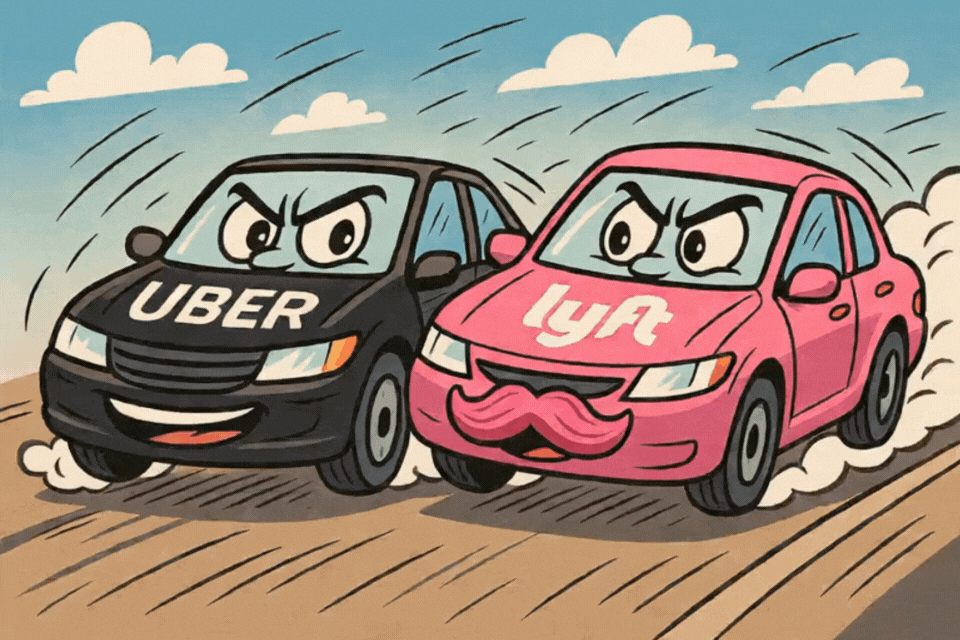Uber Technologies (NYSE:UBER) and Lyft (NASDAQ:LYFT) reported third-quarter results that showed strong operating momentum and expanding cash generation.
Uber delivered earnings per share of $3.11, beating expectations by a wide margin, with revenue growing 20.4% year over year to $13.47 billion. The company reported a 22% increase in trips and 21% growth in gross bookings, driven by steady user activity across mobility and delivery segments.
Lyft reached record highs in rider activity, driver hours, and gross bookings. Its trailing 12-month free cash flow surpassed $1 billion for the first time. The company guided to double-digit ride growth in Q4 and expects gains from its recent acquisitions.
Both companies are updating their technology strategies to support these gains.
Uber is advancing its autonomous vehicle rollout and applying generative AI throughout its platform to improve product performance and internal operations. At the same time, the company is expanding its membership program to drive more consistent engagement across delivery and mobility. Lyft is building on recent acquisitions, using FreeNow to enter new international markets and TBR to support premium and business travel. It is also beginning to bring autonomous vehicles into city networks through partnerships designed to make AVs part of its broader supply system.
These changes are aimed at product improvement, scaling infrastructure, reducing costs, and increasing the value of each user interaction.
Why It Matters: Uber and Lyft are building connected systems that coordinate activity across vehicles, users, payments, and services. These networks require ongoing upgrades to infrastructure to support better reliability and more responsive operations. When these elements are integrated effectively, companies can adapt to changing conditions and improve the efficiency of their existing assets. The real value comes from aligning digital systems with physical operations, where software decisions directly influence how movement is managed on the ground.
- Autonomous Vehicles Are Being Deployed with Hardware and Fleet Support: To support the rollout of 5,000 autonomous vehicles, Uber is partnering with NVIDIA and Stellantis. These vehicles are built on NVIDIA’s Hyperion 10 system, which supports Level 4 self-driving. Uber is also investing in the software and facilities needed to keep the fleet running and improve its performance over time. Lyft is taking a different path by partnering with Waymo. In Nashville, it is setting up a new depot to maintain Waymo’s autonomous vehicles and keep them available for riders. Lyft earns a share of each ride, whether it’s booked through its own app or directly through Waymo, giving it more flexibility in how the vehicles are used.
- AI Features Are Being Embedded Across Products and Workflows: Uber is using generative AI to improve how its platform works and how users interact with it. One example is recommending food during a trip based on the rider’s habits. Another is a new program called Uber AI Solutions, which gives people the chance to earn money by doing digital tasks like checking AI-generated answers or labeling images. Lyft is also using AI to make its service more reliable. It has improved how rides are assigned, how fleets are managed, and how prices adjust based on demand. These upgrades affect the internal systems as well as the way riders and drivers interact with the platform.
- Membership and Cross-Platform Use Are Improving Lifetime Value: The Uber One membership program is now active in 42 countries and represents a significant share of delivery bookings. People who use both delivery and rideshare spend three times more than those who use only one service, and they tend to stay on the platform longer. Uber is also adding perks through partnerships with companies like Amex and OpenTable. Lyft is seeing similar benefits through its recent acquisitions. FreeNow expands its presence in Europe, while TBR adds premium ride options in over 3,000 cities. These additions help attract international users and frequent travelers, many of whom become repeat customers with higher spending.
- Grocery, Retail, and Business Transport Add New Volume to the Network: Grocery and retail delivery have become a key part of Uber’s growth, now generating $12 billion in annualized gross bookings. This part of the business is now profitable and growing faster than restaurant delivery. Many users who start with grocery later use other services like food delivery or rideshare, helping Uber reach more customers across different areas. Lyft does not offer delivery, but it has focused on higher-value ride services instead. This includes non-emergency medical transport, airport rides, and corporate travel. These trips help fill unused driver time and work well with Lyft’s pricing and scheduling tools.
- Insurance Reform and Driving Tools Are Reducing Operating Costs: Both companies are working to reduce insurance costs. Uber uses a tool called Driving Insights to help drivers track their performance and avoid risky behavior. It also offers Advantage Mode, which gives top-rated drivers better pay and more trip options. The company expects new laws, like California’s SB371, to lower coverage requirements and reduce insurance expenses. Lyft is also seeing improvement. Its most recent insurance renewal led to only a small increase in cost per ride. In states with high insurance costs, ongoing reforms could help lower prices for riders and raise earnings for drivers, which may improve retention for both groups.
Go Deeper -> Uber Technologies Earnings Report – MarketBeat
Lyft Earnings Report – MarketBeat
Our Latest CIO Field Notes

Amazon and Meta Build Toward an Intelligent Edge
Architecting AI.
Trusted insights for technology leaders
Our readers are CIOs, CTOs, and senior IT executives who rely on The National CIO Review for smart, curated takes on the trends shaping the enterprise, from GenAI to cybersecurity and beyond.
Subscribe to our 4x a week newsletter to keep up with the insights that matter.









